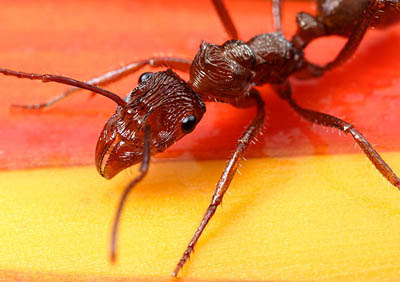
Meet Ectatomma tuberculatum. This tropical insect has the largest genome of 40 species of ants measured in a study by Neil Tsutsui et al in BioMed Central. Weighing in at 690 megabases, E. tuberculatum has nearly twice as much DNA as most other ant species, leading the authors to suggest that a whole genome duplication occurred somewhere in the line of Ectatommine ancestry.
Tsutsui et al's study, released today, is the first comprehensive genomic survey across ants. What's more, it is open access. You can read the whole thing here:
Evolution of Genome Size in Ants
Summary: Here, we report the genome size for 40 species of ants distributed across 10 of the 20 currently recognized subfamilies, thus making Formicidae the 4th most surveyed insect family and elevating the Hymenoptera to the 5th most surveyed insect order. Our analysis spans much of the ant phylogeny, from the less derived Amblyoponinae and Ponerinae to the more derived Myrmicinae, Formicinae and Dolichoderinae. We include a number of interesting and important taxa, including the invasive Argentine ant (Linepithema humile), Neotropical army ants (genera Eciton and Labidus), trapjaw ants (Odontomachus), fungus-growing ants (Apterostigma, Atta and Sericomyrmex), harvester ants (Messor, Pheidole and Pogonomyrmex), carpenter ants (Camponotus), a fire ant (Solenopsis), and a bulldog ant (Myrmecia). Our results show that ants possess small genomes relative to most other insects, yet genome size varies three-fold across this insect family. Moreover, our data suggest that two whole-genome duplications may have occurred in the ancestors of the modern Ectatomma and Apterostigma. Although some previous studies of other taxa have revealed a relationship between genome size and body size, our phylogenetically-controlled analysis of this correlation did not reveal a significant relationship.
- Log in to post comments
